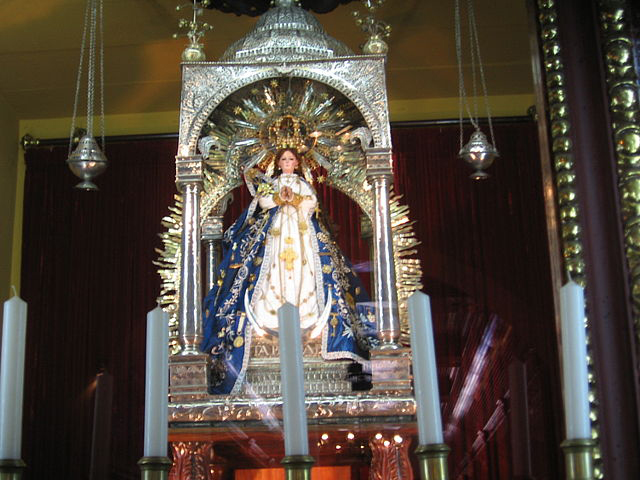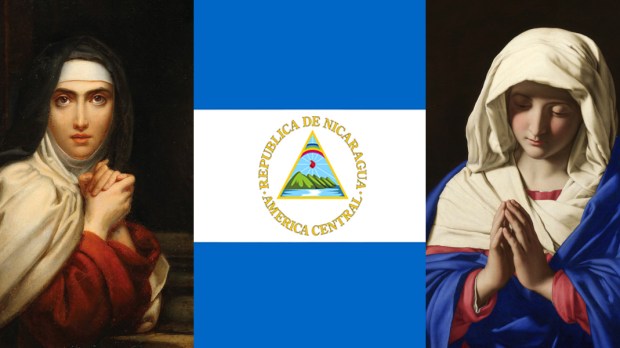Nuestra Señora de la Concepcion de El Viejo, patron of Nicaragua, literally means “Our Lady of the Immaculate Conception of the Old Man.” In this case, El Viejo is a town, named in honor of one of St. Teresa of Avila’s brothers, who lived there in his old age. Multiple accounts suggest it was her brother Rodrigo.
Rodrigo was the sibling who shared one of St. Teresa’s earliest spiritual adventures. At the age of 7, the little girl believed that she could get to heaven most immediately by going to the land of the Moors and being martyred for the faith. She convinced Rodrigo, four years her senior, to embark on this journey with her. Thankfully for their family, and for the greater Church, the pair was soon found by an uncle and brought back to their parents.
Decades later, Rodrigo traveled to Central America in his old age. His intended destination was Peru, but a storm forced the ship to land and Rodrigo found himself in Chamulpa, Nicaragua, where he remained.
Rodrigo had brought a statue of the Blessed Mother, believed to have formerly been in the possession of St. Teresa, with him when he set sail for the Americas. The local people soon grew devoted to the image and were disappointed when Rodrigo decided to again head toward Peru, taking the statue with him. Once again, however, due to bad weather, the ship was unable to travel and Rodrigo, with the statue, ended up back in Nicaragua.
This further convinced the people of Nicaragua that the Our Lady had indeed chosen them and wanted to stay among them. It is believed that Chamulpa later came to be called El Viejo in honor of Rodrigo.
The image had first arrived in Nicaragua in the 16th century. The people solemnly crowned her in 1747, and Pope John Paul II approved her papal coronation in 1989, and granted the shrine the status of Minor Basilica in 1995. The Episcopal Conference of Nicaragua declared her patroness in 2001.
Documents recording the connection between the statue, St. Teresa of Avila and her brother date back to the early 17th century. While different accounts share the same basic story line, they differ on a number of points, such as whether Rodrigo eventually made it to Peru or ended up staying with the image in Nicaragua until he died. At least one account offers the same sequence of events, but claims that it was Lorenzo de Cepeda y Ahumada, a different brother of St. Teresa, who landed in Nicaragua with the image.
While we might not know for certain which brother St. Teresa gifted with the statue, the connection between the statue and St. Teresa’s family is well established.

When the image first found its home in Chamulpa, the friars from a local Franciscan mission attracted people to visit the image by gifting them with candy and fruit. Soon, the experience of Our Lady’s presence and favors obtained through her intercession far outdid any incentive the mission could provide. Reminiscent of the early days, local sweets continue to be given to children annually on December 8, in honor of the Immaculate Conception of El Viejo.
Fireworks and “la griteria,” a form of celebratory shouting and cheering, also add to the festive spirit, joyfully reminding the Nicaraguans that their Heavenly Mother is faithfully watching over them.
Immaculate Conception of El Viejo, pray for us!
Aleteia is bringing you an introduction to some of the titles under which Mary is honored in Latin America. See here:
From El Salvador, Our Lady of Peace of San Miguel: Mary will find her way into your life with creativity and persistence
From Ecuador, Our Lady of Quinche: When God brought a child back to life through the prayers of His Mother
From Paraguay, Our Lady of Miracles of Caacupé: No two stories of Our Lady are ever the same: A mother’s individualized love
From Chile, Our Lady of Andacollo: More marvelous than all Our Lady’s apparitions and miracles put together is this simple reality
From Peru, Our Lady of Evangelization: Do you know the first evangelist?
Also see:
Our Lady of Charity, from Cuba: In the face of evacuation from Irma, turn to Our Lady of Charity
Our Lady of Aparecida, from Brazil: Pope Francis recalls the joy of entrusting his pontificate to Our Lady of Aparecida

